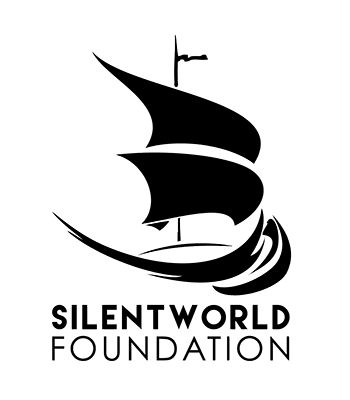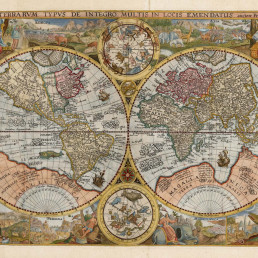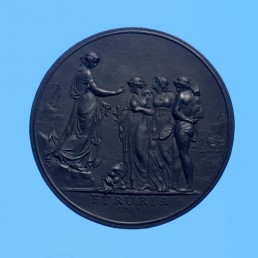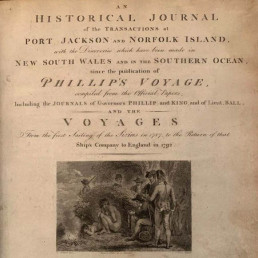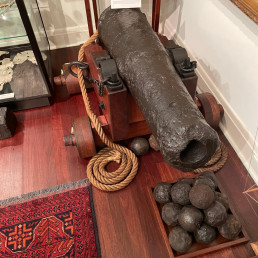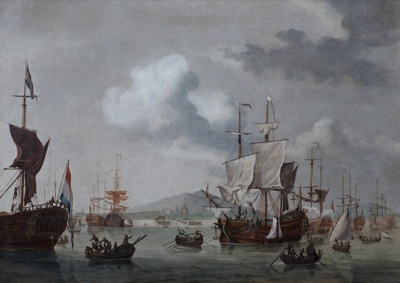
Name/TitleThe inner roadstead of Batavia
About this objectFor two hundred years Batavia (modern day Jakarta) was the headquarters of the Dutch East India Company (the VOC), and it was one of their ships, the Dufyken under Willem Janzon, that made the first recorded European visit to Australia. VOC ships sailing from Batavia made numerous further discoveries in Australia and Batavia become a major resupply and safe haven for innumerable ships from other nations exploring the Pacific, including James Cook in the ENDEAVOUR who spent three months there in late 1770, about the time this work was painted.
This is a view of the Batavia roadstead giving a good idea of the activity, the arriving and departing of ships, together with the unloading and loading of their cargoes. The view includes the prominent buildings of the time with the backdrop of the famous blue mountain. The guard ship, flying its flag from the mainmast, fired a shot every morning after the reveille and at the end of the day after the tattoo, an evening shot was fired as a signal for the other ships. Sometimes more than a hundred ships were anchored at the roadstead, the majority larger and smaller ships of the Company.
If Hendrik Kobell had not jumped out the window in delirium at age 28, then today we would remember him as one of the most celebrated painters of his day. Despite his early demise, his paintings found their way into the collections of prominent collectors like Jacob de Vos and Cornelis Ploos van Amstel and he is recognised as one of the more proficient maritime painters of the time.
MakerHendrik Kobell - Artist
Maker RoleArtist
Date Madec1772
Period18th century
Medium and MaterialsOil on canvas
Place MadeBatavia (modern Jakarta), Indonesia
Measurements590mm x 830mm
Object TypeMaritime Paintings
Object numberSF001633
Copyright Licence![]() Attribution - Non-commercial - No Derivatives (cc)
Attribution - Non-commercial - No Derivatives (cc)
Explore by category
Maps and Charts
Date range: 1541-1836
Ship Models
Date range: 1629-1890
Maritime Paintings
Date range: 1793-1849
Manuscripts and Ephemera
Date range: 1768-c1850
Medallions & Convict Tokens
Date range: 1619-1880
Landscapes
Date range: 1768-c1850
Books
Date range: 1694-c1850
Currency and Shares
Date range: 1624-1823
Printed Material
Date range: 1541-1836
Maritime Archaeology
Date range: 1629-1854
Curator's corner
New acquisitions, staff favourites and curios
The mug is decorated with an underglaze and a blue transfer print. On the body, it is titled ‘Emigrants to Australia’. This type of body and glaze was discontinued by 1840. Comparison of the handle shape and the profile of the foot, point to the attribution of manufacture by the Davenport Factory.
Delta was a ship-rigged vessel with two decks and three masts. It was built in Dordrecht, Netherlands in 1839 at the shipyard of Jan Schouten and registered in the same port. Its hull was constructed of oak and sheathed in ‘yellow metal’. Delta was owned by H. van der Sande at the time of its loss and was engaged as a cargo trader.
The Delta carried 29 crew and passengers, while sailing from Melbourne to Batavia in ballast when wrecked at Kenn Reefs on 30 May 1854 whilst under the command of Captain J.G. Kunst. This vessel loss supports the pattern of shipwrecks located on a well-travelled shipping route that was poorly charted until the mid-nineteenth century. The crew of the Delta could see four other shipwrecks at Kenn Reefs at the time of their vessel’s loss.
Important image of a ship associated with Matthew Flinders, that would shortly become one of the most famous early shipwrecks in eastern Australian waters. This is a fine ship’s portrait, by one of the great exponents of the art
